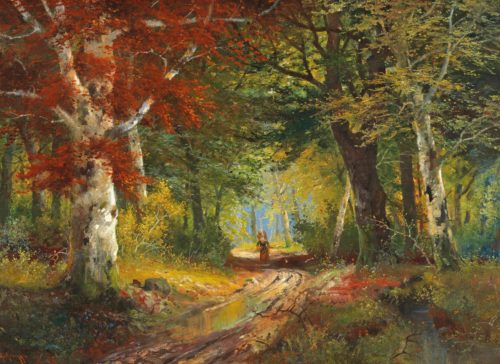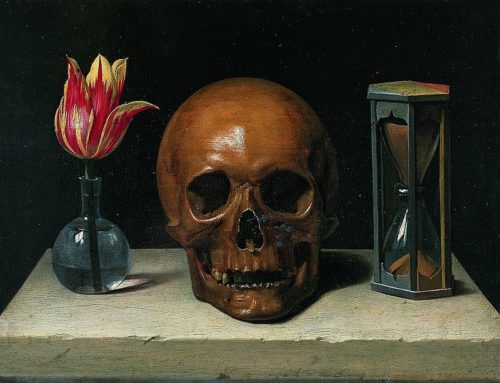Pagan Perspectives
[Today’s piece is a guest submission by Carrie Pitzulo. Carrie Pitzulo holds a Ph.D. in American History, but she would rather talk about ghost hunting, tarot cards, or her dinner with Hugh Hefner. Spiritual and metaphysical exploration is a lifelong passion that has brought Carrie to writing, teaching, and mentoring women on alternative spiritual paths. You can follow Carrie on Instagram, Facebook, or her personal website, Ancient Magic Modern Living.]
It began at this time last year, autumn eve, when my three-year-old daughter asked me to play dead. We did this on several occasions until she solemnly inquired, “What is die?” Unprepared, I fumbled through a lame, stuttering answer.
I’ve always considered myself tremendously lucky because death has not come knocking in my life too closely or too traumatically. There have been losses, of course, but nothing I couldn’t recover from. I know it can be otherwise, and it is for many people. Even so, over the last year, the death crone has eased herself into my life. I’m trying to dance with her in a way that keeps her sated without offering her too much of my heart.
As an earth-based spiritualist, I’ve come to appreciate the magic of the growing darkness of autumn, the turn inward, and the reminder to slow down. We honor the dying season when the trees go bare and the landscape becomes stark. The lesson of the fall and winter is that even in the midst of cold and dark, there is hope of returning warmth, light, and life in the spring.
That’s easy to accept when we are just talking about falling leaves. When we feel secure, the cycles of life and death can remain at a safe, philosophical distance. But last year, inevitably, the lessons of the dying season became more real to me. I could feel the crone creeping closer. I warned my spouse and prayed death wouldn’t visit too intimately with us.

Alois Arnegger http://www.tuttartpitturasculturapoesiamusica.com
The crone arrived in November with a dead squirrel that my daughter and I encountered on a walk. She insisted on really looking at the squirrel, communing with it, discussing it. My child said very solemnly that although it was scary, it also made her feel “a little happy.” Then, unexpectedly, our blessing of “safe travels” opened up a well of sadness in her that stunned me. She connected that phrase with a time when “we tried to go home.” She sobbed and then shut down about the experience, telling me she didn’t want to talk about it. I had no idea what she was talking about and couldn’t make sense of the depth of her emotion other than to suspect that it was not from this lifetime.
The next day, we lost my aunt to cancer. Both my daughter and I spent the winter trying to comfort my 98-year-old grieving grandmother. After Valentine’s Day, my ancient, beloved cat died. Late this summer, a dear, elderly friend passed away. While I continue to count myself lucky, death has visited, as I knew she would.
It’s not just these recent losses. By late spring my ancestors seemed to call to me from a deeper layer of death. A series of synchronicities brought me on a long-distance journey to meet my great aunt, the last living relative of my paternal grandmother’s family, most of whom I had never known. Somehow that visit triggered in me, like the squirrel had in my daughter, a stream of sadness. Not really knowing why, I cried for days, with a vague sense of longing for greater connection with this lineage. Unlike my daughter’s experience, though, this felt not like a past life memory, but rather the grief of my ancestors, flowing through me after years of loss and separation.
Daniel Foor, Pavini Moray, and others discuss the ways in which our ancestors not only continue to exist, but also affect our daily lives. They may have a positive or a negative influence. If we do not address their needs and their healing, ancestral pain and trauma will continue on through us to our descendants. Science has begun to bear out this ancient knowledge. This is heavy work that I’ve only just begun. But I believe that in dancing with the death crone, I’ve become much closer to my ancestors. In giving them greater care and attention, I’ve experienced healing shifts in my own life.
Since last autumn, I’ve felt this energy, like a river of life and death – because it is one and the same, life and death – flowing through me and around me. I’ve grieved my recent dead. But I have also developed a greater appreciation for and awareness of the longer dead. I can hear them calling to me in ways that are vibrant and life-affirming. It’s like we, the living, look down at this river and imagine that we see ourselves reflected back in its waters. But maybe it’s not our faces that we glimpse, but theirs, our dead, looking up from the other side. We believe it is us that we see when we look at their murky, distant faces. We believe it is us, because in a very real way, it is. They are us and we are them. We carry their pain, trauma, joy, and gifts within.

Vanitas, by Phillippe de Champaigne. Life, Death, and Time [Wikimedia Commons].
Many of us have lost the healing power of ancestral reverence, but this is the perfect time to reclaim it. We can work with this energy by seeking out the history of our family lineage, painful though it may be. One way of doing this is through genealogical research, or by connecting with our elders and listening to the old stories that run in our blood. Another way is by creating ancestor altars. Include photographs, belongings, or symbols of those who came before, even when we don’t personally remember them. Allow the altar to be a place of reverence and a reminder that we are not the beginning or the end.
Now, a year since this energy gathered, I pray more intently for all of us – the living, may we continue to be; the dead, including the ones I only recently learned to claim as mine. Last year, I felt the foreboding, and then grief and sadness. I hope no more will come anytime soon. But as we sit again on the cusp of the season of the death, of the season of the ancestors, I continue the all-too-human work of learning to flow with the river of life and death. Because no matter the side from which we gaze, the river itself is alive, and endless.
* * *
The views and opinions expressed by our diverse panel of columnists and guest writers represent the many diverging perspectives held within the global Pagan, Heathen and polytheist communities, but do not necessarily reflect the views of The Wild Hunt Inc. or its management.
The Wild Hunt is not responsible for links to external content.
To join a conversation on this post:
Visit our The Wild Hunt subreddit! Point your favorite browser to https://www.reddit.com/r/The_Wild_Hunt_News/, then click “JOIN”. Make sure to click the bell, too, to be notified of new articles posted to our subreddit.
